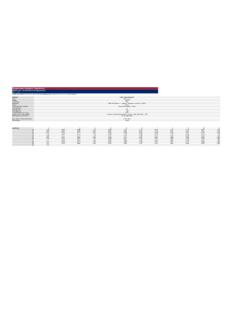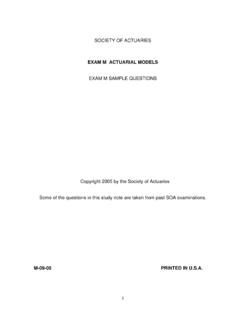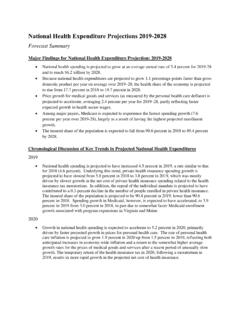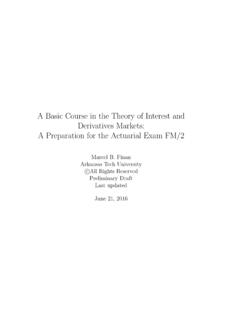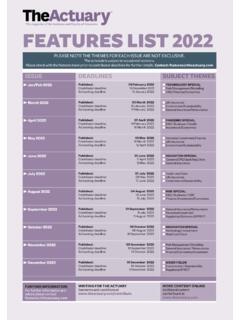Transcription of National Health Expenditure Projections 2018-2027
1 National Health Expenditure Projections 2018-2027 Forecast Summary Major Findings for National Health Expenditures: 2018-2027 Under current law, National Health spending is projected to grow at an average rate of percent per year for 2018-27 and to reach nearly $ trillion by 2027. Health spending is projected to grow percentage point faster than Gross Domestic Product (GDP) per year over the 2018-27 period; as a result, the Health share of GDP is expected to rise from percent in 2017 to percent by 2027. Key economic and demographic factors fundamental to the Health sector are anticipated to be the major drivers during 2018-27. Prices for Health care goods and services are projected to grow somewhat faster over 2018-27 ( percent compared to percent for 2014-17). As a result of comparatively higher projected enrollment growth, average annual spending growth in Medicare ( percent) is expected to exceed that of Medicaid ( percent) and private Health insurance ( percent).
2 The Medicare enrollment impacts are the key reason the share of Health care spending sponsored by federal, state, and local governments is expected to increase by 2 percentage points over the projection period, reaching 47 percent by 2027. The insured share of the population is expected to remain stable at around 90 percent throughout 2018-27. Chronological Discussion of Key Trends in Projected National Health Expenditures 2018 National Health spending is projected to have grown percent in 2018, up from percent growth in 2017, and to have reached $ trillion. Faster projected growth in Medicare spending of percentage points (to percent) primarily drives the projected acceleration. Price growth, as measured by the personal Health care price index, is projected to have increased from percent in 2017 to percent in 2018, due primarily to faster economy-wide inflation. 2019 National Health expenditures are projected to grow percent in 2019, up from percent growth in 2018, and to reach $ trillion.
3 Higher fee-for-service payment updates are expected to result in faster Medicare spending growth ( percent) while expanded eligibility for Medicaid in Idaho, Maine, Nebraska, Utah, and Virginia is projected to contribute to faster Medicaid spending growth (from percent in 2018 to percent in 2019). Somewhat lower private Health insurance enrollment related to the repeal of the Affordable Care Act s individual mandate is expected to be partially offset by gains in other types of Health coverage and result in a slight decline in the insured share of the population in 2019 ( percent compared to percent in 2018). 2020-27 For 2020-27, National Health spending growth is projected to average percent, from percent in 2019, and reach nearly $ trillion by 2027. With nominal GDP growth expected to average percent during this period, the Health share of GDP is expected to increase to percent by 2027, from percent in 2019.
4 Personal Health care prices are projected to grow by percent per year on average over 2020-27, percentage point more rapidly than in 2019, partly due to faster expected growth in Health sector wages. Utilization growth is projected to be higher over 2020-27 for Medicare beneficiaries, as well as for those with private Health insurance (in lagged response to faster projected income growth over 2020-22). Key Trends in Projected National Health Expenditures by Payer Medicare Medicare spending growth is projected to have accelerated to percent in 2018 from percent in 2017. Contributing to this acceleration is faster per enrollee growth ( percent in 2018 versus percent in 2017) from higher private Health plan payments, as well as higher spending growth for hospital care and prescription drugs. In 2019, Medicare spending growth is projected to accelerate again to percent related to higher fee-for-service payment rates.
5 Over 2020-27, Medicare spending is projected to grow by percent per year on average, or percentage point more rapidly on average than in 2019, reflecting the expectation of a continued rebound in growth in the volume and intensity of Medicare services to rates more similar to the program s long-term historical experience. Medicaid Medicaid spending is projected to have grown more slowly in 2018, at percent from percent in 2017. This slower spending growth is more than accounted for by decelerating growth in enrollment, which is projected to have grown just percent in 2018 compared to percent in 2017. In 2019, however, Medicaid spending is projected to accelerate to percent, largely due to a percentage point acceleration in enrollment growth to percent in 2019. This faster enrollment growth reflects the effects of the expansion of the program in five states in 2019. Over 2020-27, growth in Medicaid spending is projected to rise further to an average of percent per year, influenced by faster per enrollee spending growth.
6 Underlying this faster growth in per enrollee spending is an expectation of an enrollment mix more heavily influenced by spending patterns of comparatively more expensive aged and disabled beneficiaries. Private Health Insurance and Out-of-Pocket Private Health insurance spending growth is projected to have accelerated slightly to percent in 2018, from percent in 2017. This trend is the net effect of faster spending growth in many services such as physician and clinical services and prescription drugs, which were only partly offset by slower projected growth in the net cost of private Health insurance spending. In 2019, private Health insurance spending growth is expected to slow to percent, which partly reflects the estimated impact of the effective repeal of the individual mandate. Because some people may choose to forgo maintaining Health insurance due to the repeal of the mandate, private Health insurance enrollment is expected to decline slightly, which in turn contributes to the slower projected spending growth in 2019.
7 Over the latter period of the projection, 2020-27, private Health insurance spending is projected to grow by percent per year on average (or percentage points more rapidly on average than in 2019) resulting mainly from the lagged response to higher projected income growth, especially in 2020-22. Out-of-pocket spending growth is projected to have grown faster at percent in 2018, from percent in 2017, due to faster income growth, as well as higher average deductibles for private Health insurance enrollees with employer sponsored insurance. In 2019, out-of-pocket spending is expected to grow more rapidly, at percent, in part because fewer people have private insurance coverage due to the effective repeal of the individual mandate. Over 2020-27, out-of-pocket spending growth is projected to accelerate from 2019 to an average annual rate of percent, which is a similar rate as private Health insurance during this period.
8 During this timeframe, somewhat faster growth is projected for 2022, a year in which OOP spending is anticipated to grow percent related to the excise tax on high-cost insurance plans. Key Trends in Projected National Health Expenditures by Sector Prescription Drugs After having grown just percent in 2017, prescription drug spending is projected to have grown percent in 2018. This acceleration is due to faster anticipated utilization growth partially driven by an increase in new drug introductions. Prescription drug spending growth is then projected to further accelerate to percent in 2019, because of faster utilization growth from both existing and new drugs, as well as a modest increase in drug price growth. For the reminder of the projection, 2020-27, prescription drug spending is projected to grow by percent per year on average, or percentage points more rapidly than in 2019, influenced by higher use anticipated from new drugs and efforts by employers/insurers that encourage patients with chronic conditions to consistently treat their disease.
9 Hospital Hospital spending is projected to have grown percent in 2018, which is slightly slower than the rate observed in 2017 of percent. This similar, but slightly lower, rate of growth is largely due to slower growth in both Medicaid and private Health insurance hospital spending in 2018. In 2019, because of faster Medicare spending growth (higher hospital payment updates) and Medicaid spending growth (higher use associated with the new expansion-related enrollees), hospital spending growth is projected to have accelerated percentage point to percent. Hospital spending growth is projected to accelerate to percent per year on average over 2020-27, because of faster spending growth from all payers (and Medicare in particular). Also contributing to faster growth over 2020-27 is somewhat higher price growth arising from expected increases in wage growth and tighter labor markets for hospital employees. Physician and Clinical Services Physician and clinical services spending is projected to have grown more rapidly in 2018, at percent, from percent in 2017.
10 This faster spending growth reflects an acceleration in price growth of percentage point to percent (which is still near historically low rates) and also reflects higher anticipated use (related to the lagged response to income growth and more office visits due to a severe 2017-18 flu season). Growth in physician and clinical services spending is projected to accelerate in 2019 to percent, which is primarily associated with higher use arising from the Medicaid expansion in five additional states. Over 2020-27, physician and clinical services spending is projected to grow by percent per year on average. During this period, growth in Medicare spending on physician and clinical services is expected to be faster than growth in private Health insurance spending on the sector largely due to the continued shift of the baby-boom generation from private Health insurance into Medicare. Also contributing to the overall trend is faster projected growth in prices for physician and clinical services due to anticipated rising wage growth related to increased demand from the aging population.











